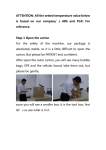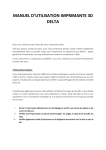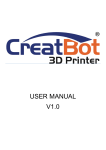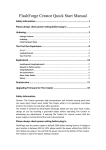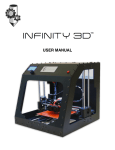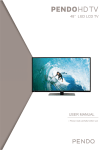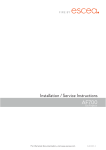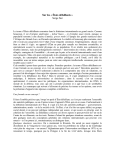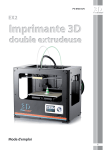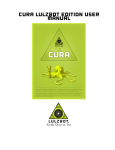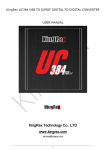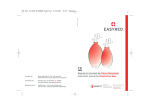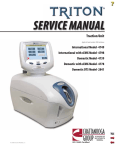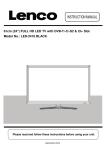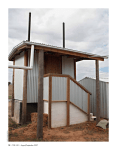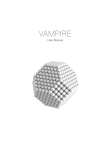Download - CreatBot 3D Printer
Transcript
CreatBot 3D Printer User manual English V7.0 Henan Suwei Electronics Technology Co., Ltd. - 1- CONTENTS Notice ················································ 3 Model Mirror ·························· 19 Machine Diagram View Mode ······························ 19 Front and Back ························· 4 Right Click on Model ············ 20 Hotend / Feeder ····················· 5 Toolpath Structure ················ 20 Basic Setting ··························· 21 Hardware Installation Advanced Setting ················· 22 Unpacking ································· 6 Install Build Platform ············· 7 Expert Setting ························ 23 Install Feeder ····························· 8 Skirt/Brim/Raft ······················ 24 Plugins ····································· 24 Printer Operation Start/End GCode ·················· 25 LCD Screen ································ 9 Keypad / Knob ························ 9 Dual Head Printing ·············· 25 LCD Menu Tree ····················· 10 Align Dual Head Horizon ··· 26 Leveling Platform ················ 11 Align Dual Head Vertical ···· 27 Paving Crepe Paper ············· 11 Add Multi Type Printer ······· 27 Frequently Asked Questions Load Filament ························ 12 Routine Maintenance ········· 28 Unload Filament ··················· 13 Print PLA and ABS ··············· 28 Software Operation Paving Kapton ······················ 29 CreatWare Setup ·················· 14 Quick Print UI ······················· 15 Change Fuse ·························· 30 Print Your First Model ········ 15 Adjust Z Limit ························ 30 Full Setting UI ······················· 16 Hardware Troubleshoot ····· 31 Mouse Operation ················ 17 Printing Troubleshoot ········ 32 Model Rotate/Scale ············ 18 Specifications ······························ 33 Icon conventions Tip icon to remind users to have a good method or technique. Note icon, to remind the user must be given adequate attention. Prohibition icons, prevents users from unauthorized operation. 26 Jun 2015 - 2- Notice Read First Thank you for choosing CreatBot 3D printer! This manual contains important information about the installation, use, maintenance and common problems of CreatBot 3D printer. Please read this manual carefully before using 3D printer. All losses caused by the breach of the notes and the operation process of the operation process will be borne by the user. Please use the filament provide by CreatBot, or high quality filament of third manufacturers. Due to the use of third party inferior material caused by the failure of the printer, the loss will be borne by the user. Software running environment, 2G or above processors, at least 1G memory, compatible with Windows, MAC, or Linux, please use memory as much as possible. I wish you a fun with CreatBot! Danger Warning The nozzle's temperature will reach 300 degrees, don't touch. The platform's temperature will reach 120 degrees, don't touch. Please make sure that the printer connected to the ground. Do not attempt to open the case, be careful of electric shock. Working Environment The 3D printer can work in the indoor environment of 5 ℃ to 30 ℃. Long-term not use of the printer, be sure to dust, moisture. Long-term not use of the filament, please be sealed to prevent deterioration. - 3- Machine Diagram Front and Back 1. Power switch 2. SD-card slot 3. Keypad 11 4. LCD display 5. Leveling nut 6. Leveling spring 7. Build platform 10 8. Baffle holes 9 9. X stepper motor 8 10. Printer head 7 11. Filament guide pipe 6 5 4 3 20 2 19 18 1 17 16 12. Power socket 15 13. Spool holder 14. Filament 15. Z stop limit 16. Filament inlet 17. X stop limit 18. Filament feeder 1 14 19. Compression nut 13 20. Filament feeder 2 12 - 4- Machine Diagram Printer Head 1. Thermostat tube 13 2. Heating tube 12 3. Nozzle 11 4. Heating block 10 5. Fan duct 9 6. Insulation tube 8 7 6 7. Cooling fan 8. Head Al. frame 5 9. Adapter plate 4 10. Head adjust 3 11. Linear bearing 2 12. Linear axis 1 13. Head main block Head will be update at any time. Filament Feeder 1. Pressure arm 5 11 10 3. Pressure nut 4. Wire socket 5. Geared motor 4 9 6. Filament inlet 7. Filament sensor 3 8 2 2. Pressure spring 8. Feeder body 7 9. Feeding wheel 6 11. Pipe joint 10. Fixed hole 1 - 5- Hardware Installation Unpacking Unpacking Takeout accessories Takeout filament Turn on printer 1. Ensure the packing is not broken. 2. Need two people at the same time. 3. Lift it out by grasping the frame, not the belt or rails. 4. Takeout the accessories, will see the bracket and the filament. 5. Turn on the printer, enter "Move axis" menu, select "Auto home", the bracket will rise, now you can takeout filament. Tips: Press - 6- same as "Auto home". Hardware Installation Install Build Platform Takeout platform Insertplatform Connect the cables Tighten the screws 1. Enter "Move axis" menu, move the platform a little down. 2. Fix the M5 screw to the hole of bracket, do not tighten. 3. Insert platform to the bracket, the bracket is between plate and tray. 4. Aim the tray fix hole to the M5 nut, then tighten the screws. 5. Connect the power plug and temperature sensor plug. Notice: Ensure the plug is well contacted. - 7- Hardware Installation Install Feeder Fixed feeder Connect joint Install spool's holders Plugin cable 1. Take out the feeder, pay attention to the order between left and right feeder. 2. Mount the feeder fixing hole on the back the chassis. 3. Tighten the screw nut firmly with a wrench. 4. Tighten the joint nut firmly on the feeder. 5. Plug in the motor cable to the socket. 6. Install spool's holders. 7. Install rack sleeve, you can download it from our website. Notice: Feeder must same order to the nozzle. - 8- Printer Operation LCD Display 1 2 3 4 5 6 7 8 9 1. Current temp. 1 9. Fan speed 2. Target temp. 1 10. Cur. Z position 3. Current temp. 2 11. Remaining time 4. Target temp. 2 12. SD card icon 5. Current temp. 3 13. printing speed 6. Target temp. 3 7. Cur. hotbed temp. 8. Tar. hotbed temp. 13 12 11 10 Keypad KEY Z- FUNCTION Up OK Z+ Down OK KEY FUNCTION - Move Z up + Move Z down Z Z OK Browse SD card Status/Home Pause/Resume Preheat nozzle/bed, and switch between them Notice: Up/Down can change global print speed. Knob 1. Push knob to confirm, rotate to move up down. 2. Ratate knob can change global print speed. PUSH - 9- Printer Operation LCD Menu Preheat PLA Preheat ABS Preheat nozzle 1 Preheat nozzle 2 Preheat nozzle 3 Cooldown Preheat hotbed Preheat Auto home 10 mm X axis 1 mm Y axis 0.1 mm Z axis Move axis Tune Status Change filam. Preheat All Extruder 1 Extruder 2 Filament Unload 1 SD card Pause print Cancel print Setting Unload 2 Temperature Leveling bed Ysteps/mm Motion Zsteps/mm Save setting Esteps/mm Factory setting Firmware Ver. Display while printing Xsteps/mm Time used - 10 - Reg. Number Printer Operation Leveling Platform 2 3 1 4 1. Enter setting menu->leveling bed, waiting for the platform back to home. 2. Adjust first leveling nut, make nozzle close to the platform. 3. Press Up/Down button or rotating knob, adjust other three leveling nut. 4. To adjust repeatedly, eventually distance (0.2mm) to insert a name card is advisable. 5. All the leveling nut should uniform, nozzle can't too close to the platform. 6. All will be subject to the actual effect of print, please make more little adjust at the beginning of printing. Paving Masking Paper Platform need paste masking paper or Kapton to achieve best viscosity, and the model will be firmly fixed on the platform. Kapton is double-sided tape, please tear film on both sides. - 11 - Printer Operation Load Filament Back Preheat 1 PLA Preheat 2 PLA Preheat all PLA Preheat bed PLA Preheat head Straightened filament Tighten the nut Load filament 1. Preheat the head you want load filament. 2. Straightened filament and check the filament is not self-winding. 3. Insert the filament to the inlet and push it to the nozzle, until melted and flowing naturally. 4. Tighten the compression nut, tightness is "back a circle after firmly" is appropriate. Notice: Pressed filament too tight or too loose will affect normal wire feeding. - 12 - Printer Operation Unload/Change Filament Back Extruder 1 Extruder 2 Unload filament 1 Unload filament 2 Head heating: 210℃ Unload filament menu Preheat head Unloading ...... Pull out filament Unloading filament 1. Enter "Filament" menu ->"Unload filament", and select the head you want unload. 2. Wait for the nozzle heated to a suitable temperature. 3. After reching temperature, feeder will send a certain number of filament, and then automatically withdraw filament. 4. To manually unload filament, same as above mentioned. Warning: It is strictly prohibited without heating nozzle. Tip: If filament stuck in the guide tube, continue printing several lengths and retry. - 13 - Software Operation CreatWare Setup Download CreatWare installation package from the CD-ROM or www.CreatBot.com, follow the prompts to install the software, tr y using the default installation path as well. Please associated common 3D file format. Installation path can not contain non-Latinn characters. Please associated common 3D file format. When there is a driver digital signature, please choose to agree. When finished the driver folder will locate at installation directory. The software will select the correct language according to your OS, please select the right machine type and number of nozzles and ignore the other option and guide. - 14 - Software Operation Quick Print UI 1 Load model 3 Save toolpath Normal Overhang 2 Transparent X-Ray Layers When insert SD card, the toolpath will saved to the SD card. The file name can not contain non-Latinn characters. Print Your First Model Insert SD card to the card reader, open the CreatWare, load 3D model file[1], choose correct filament and option [2], finally click save button[3], you can now finish slice model. Insert SD card to the printer, browse and select the Gcode file you just saved, the printer will automatically start to heating, when the temperature reaches, the printing will start. - 15 - Software Operation Full Setting UI Load model Save toolpath Manual slicing View mode Setting area View area Rotate Zoom Mirror As you can see from the complete UI, the left side of the software is setting area, the right side is view area. The setting area contain "Basic", "Advanced", "Plugins", "Start/End GCode" four tabs. The Basic tab is the most common settings, usually the most frequently used parameters are here. Each parameter has a mouse-over tips, you can set parameters according the prompt. If you want to restore the default settings, please click on the menu "Tools"->"Restore Default". Tip: Double-click view area can quickly load 3D model file. The view mode and edit icon will appear when you select the 3D mode. - 16 - Software Operation Mouse Operation Left click Right click Select model, hold and move to change position, double-click to load 3D models. Hold and move to rotate the viewpoint around the 3D model. Left + Right Scrollwheel Hold and move the Use the scroll wheel to mouse to zoom. zoom in or out. Left + Shift + + Click and drag in rotary model can according to each 1 degree angle. Shift Right + Shift Hold and move the mouse to pan the 3D view. Shift Keyboard Shortcut Ctrl+L Load model/Picture Ctrl+S Save model as Delete Remove model F5 Refresh view area Ctrl+E Export setting Ctrl+, Preferences - 17 - Software Operation Model Rotate Click on the left corner of the rotate button [1], you can see three ring line around the model, respectively along the X, Y, Z direction. The default rotation angle is 5 degrees, press the Shift key can restrict 3 the rotation angle to 1 degree. Button [2] to is the reset 2 button, can restore rotate status to the default state. 1 Button [3] is lay flat button, can lay the model flat on the platform automatically. Model Scale Click the left corner of the zoom button [1], you can see a contour line around the model, and shows the current size of the model. You can input the value of the zoom ratio in Scale X / Y / Z , may also directly enter the size you need. Button [4] indicates 3 locking scaling. Button [2] is zoom reset 2 4 button, you can restored the model to the default size. 1 Button [3] for the zoom model size to the maximum print size. - 18 - Software Operation Model Mirror Click the mirror button [1], you can pop up the mirror menu. Button [2] is a mirror along the X axis. Button [3] is a mirror along 4 the Y axis. Button [4] is a mirror along 3 the Z axis. Note that the mirror 2 transformation is different from the rotation, such as the mirror 1 transformation will lead to a change in the direction of rotation, and the rotation will not change the model. View Mode From the overhang view, you By slice view can easily observe can see the suspended part of the the generated path, you can easily model which is shown in red color. observe the different layers of sliced By changing the supporting angle by slicing altitude indicator, use Ctrl can be seen suspended parts size is + arrow keys can also be observed dynamically changing. layer-by-layer. - 19 - Software Operation Right Click on Model Right-click on the model pop-up shortcut 1 menu, here are more features: 2 [1] "Centered" make the model back to the 3 center position of the platform. [2] "Delete" to 4 5 remove the currently selected model. [3] "Multiply" to copy the currently selected model and 6 automatically position, which is useful for printing more than one model at a time. [4] "Split" multi- component model can be split into its separate components, this process more timeconsuming, try to split the model in the modeling software, models splited can be printed individually and then assembled together . [5] "Delete All" to delete all the models loaded. [6] "Reload all" Reload all models, same as F5. 3 4 Toolpath Structure Red represents "outer shell" Yellow represents "infill" Green represents "inner shell" Blue represents "support" Purple represents "bottom and top shell" Drag layer indicator can browse different level paths, Ctrl + arrow keys to browse layer by layer. 3D printing is the superposition of these different layers and built layer by layer. - 20 - Software Operation Basic Setting Layer height: This is the most important setting to determent the quality of your print, maximum value not exceed 80% of the nozzle diameter. Shell thickness: Refers to the total thickness of the inner and outer walls, the outer wall is only one, the inner wall can be more, set this value to an integer multiple of the diameter of the nozzle. Flow: Refer to the amount of printing material, 100% standard dosage, the more material the model prints more plump. top/bottom thickness: Is the thickness of the upper and lower models, usually a multiple of layer height. Fill density: Control how density filled the insides of your print will be, a value around 20% is usually enough, 0% for hollow. Print speed: Speed at which printing happens. Print speed is affected by many factors, it is recommended to use low speed for complex model, high speed will cause the feed shortage, need improve nozzle temperature to compensate. Nozzle temperature: Is the melting temperature of filament, general use 200 ℃ for PLA and 240 ℃ for ABS. Bed Temperature: General use 45 ℃ for PLA and 70 ℃ for ABS. Default main head: The default is the first nozzle, can also be set to other nozzles, this can reduce the times of changing filament. Support type: The touching build plate support type is shown in figure [A], everywhere support is shown in figure [B]. Support angle: The larger the angle, the more support generate. Fill amount: The larger the fill, the more support generate. Platform adhesion type: The model which is not easy adhesion on the platform please use Brim, which easy to warped or ABS filament please use Raft. Support Type A - 21 - B Software Operation Advanced Setting Solid fill top: Refers to whether to print the top surface of the model, uncheck will print it with infill method. Solid fill bottom: Same as above, and so on. Spiralis print: Refers to the method of spiral printing the outer wall of the model (single layer), and this feature is very suitable for print glass vase model. Enable retraction: When the nozzle is moving over a noneprinted area, withdraw a certain length length filament to prevent overflow. Retract speed: The speed of retraction, too fast can lead motor out of step, too slow increase printing time. Retract distance: The length of the filament when enable retraction. First layer thickness: Height of the first layer of printing, generally greater than 0.15mm. First layer flow: When the set of the first layer is too high, it can be appropriate to increase the extrusion. Cut off object bottom: This can be used for objects that do not have a flat bottom. Continue print: Being "power outages continued" be substituted. Travel speed: The speed when moving over a non-printed area. First layer speed: Slightly slow speed can enhance adhesion model on the platform. Solid layer speed: The speed is a percentage here, which reference to the global print speed, a combination of different speeds, you can both get a good print quality and a faster print time. Spiralise Printing - 22 - Software Operation Export Setting Nozzle size: Set the nozzle size. Diameter: Accurate measurement of your filament gives better quality prints. Minimum travel: The minimum distance which can trigger filament retract. Minimum extrusion: The minimal amount of extrusion that needs to be done before retracting. Enable combing: Combing is the act of avoiding holes in the print for the head to travel over. Wipe tower: Is a small tower next to your print where the nozzle wipes itself clean when switching nozzles. Dual extrusion switch amount: Amount of retraction when switching nozzle with dualextrusion, a value of 15mm seems to generate good results. Cooling fan: The extra cooling fan is essential while printing small model, but when print ABS material, the max fan speed should not more than 50%. Skirt: The skirt is a line drawn around the model at the first layer. This helps to prime your extruder, and to see if the model fits on your platform. Brim: The amount of lines used for a brim, more lines means a larger brim which sticks better. Raft: If the raft is enabled, this is the extra raft area around the object which is also rafted. Increasing this margin will create a stronger raft while using more material and leaving less are for your print. Notice: Most of the setting have been optimized, If you want restore default configuration,use the menu "Tools"->"Reset profile to default". - 23 - Software Operation Skirt · Brim · Raft Adhesion type: None Adhesion type: Brim Adhesion type: Raft Plugins Plugin enable you to easily include 1 your own features, without having to modify the source code or Gcode. In the screen shot above, these can be enabled by clicking on the arrow down 2 button, then you can configure the plugin. 3 Notice: Please remove the plugin before you close the software. - 24 - Software Operation Start / End GCode The start and end gcode are the startup and end procedure of the print, editing this requires knowledge of GCode. If you want to set the automatic heating station after printing, you can remove the ";" in the code ";M190 S50". start.gcode is the start code of single extruder, start2.gcode is the start code of double extruder, and so on. Dual Head Printing Step 1: Load 2 models A B C you want as shown in figure [A] and [B]. Step 2: Fist click [A], then right click on [B], you will get the option: dual extrusion merge, this will merge both models into one model [C]. Step 3: Set parameters like ordinary single color model and save the GCode. Tip: The model select first will print by main extruder, the right clicked one by second extruder. - 25 - Software Operation Align Dual Head Horizontal There are alignment problem while printing dual color model, this is because the small difference in multi-nozzle assembly, CreatWare built fine-tuning features. Click menu "Machine">"Machine settings", default X offset is: 20.0, default Y offset is: 0.0, adjustment method as shown below: Extruder 2 Extruder 2 Offset X : 20.3 Offset X : 19.7 Offset Y : 0.3 Offset Y : -0.3 Extr. 1 Extr. 1 Extr. 2 Extr. 2 - 26 - Software Opertation Align Dual Head Vertical Step 1: Raised the right nozzle. Rotate left to raise the head, rotate right to lower head, the full rotation adjustment range is 1mm per round. Step 2: Leveling platform with the left nozzle. 。 Step 3: Lower right nozzle step by step align with the left nozzle. Tip: You can rising right nozzle as long time not use. Add Multi Type Printer You can add more than one type of CreatBot to the software, and easily switch between them without re-config all the different machine settings. - 27 - Frequently Asked Questions Routine Maintenance 1. Frequent cleaning stains on the rail. 2. Lubricate the four guide rail. 3. Frequent cleaning feeder gear. Notice: Don’t add too much lubricating oil. Print PLA and ABS Nozzle Bed Close bed Adhesion Cooling Tape Enclosed PLA 200 ℃ 45 ℃ Timed close None/Brim Max. 100% masking Can open ABS 240 ℃ 90 ℃ Always Brim/Raft Max. 50% Kapton Enclosed * The data is only for reference, different environmental data will be different. - 28 - Frequently Asked Questions Paving Kapton 1. Clean the platform first. 2. Kapton is a double-sides adhesive. 3. Paste the first side on platform. 4. Then another side. 5. Pierce the bubble. Tip: Kapton temperature resistance up to 120 ℃ , the film can be reused until not sticky so far. - 29 - Frequently Asked Questions Change Fuse Open fuse tray Change new fuse Note: Please use the 10A fuse. Adjust Z Limit If the nozzle can't touch the platform even loosen all the leveling nut, you can move Z stop limit a little up, as you can see from figure. - 30 - Frequently Asked Questions Hardware Troubleshoot 1. Display "MINTEMP" ? The environment is too low, or temperature control tube is damaged, please keep the room temperature above 0 ℃ . 2. Display "MAXTEMP" ? Temperature of nozzle or bed too high, or temperature control tube is damaged, please keep their temperature in a suitable range. 3. USB connection problems ? Please specify the correct port and baud rate (250000), or change a shorter USB cable. 4. Nozzle heats up too slowly ? Temperature in door is too low, or use a fan duct, or turn up output voltage (24.5v). 5. Print head stuck ? Clean the guide rail and add lubricating oil. 6. Print head can not move ? Stepper motor chipset burned, or belt damaged, or belt wheel screw loose. 7. Print head hit the framework ? Corresponding axis stop limit or circuit fault. 8. Unable to power on ? Power switch is damaged or fuse is burned, and please check whether the power adapter is working properly. Printing Troubleshoot 1. How to set the temperature of the nozzle ? Different filament temperature is different, general as follows: PLA temperature 190 ℃ ~210 ℃ ABS temperature 230 ℃ ~250 ℃ You must leave enough time for filament heating, so the faster printing speed need the higher temperature, 60mm/s temperature need raise about 10℃. In the same way, larger thickness need higher temperature. 2. How to set the temperature of the hot bed ? The main purpose of the hot bed is to prevent model wrapped, PLA need about 45℃ and 70℃ for ABS is enough, but due to the environment and filament, we often need to increase the temperature, the highest temperature - 31 - Frequently Asked Questions Printing Troubleshoot not over 120℃, and you can close the bed above 100mm. 3. The model not stick on the platform ? Please paste masking paper or Kapton on the platform, or the nozzle is too far away from the platform, or the bottom of the model is not flat. 4. No or less silk coming on the first layer ? The distance between nozzle and platform is too small, or the filament has not been sent to the nozzle. 5. Why nozzle is not spit silk ? The filament is not pressed or too tight, or print temperature is too low, or the filament feeder not working. 6. How to prevent model become warped ? Increase hot bed temperature or use Kapton, or change platform adhesion type to Raft, or cover the baffle, or reduce indoor ventilation. 7. How far from nozzle to platform appropriate ? Distance should be 0 in theory, but there is no absolute flat platform, so the distance should +-0.1mm. Finally, with the actual printing effect as the standard, too close will lead to a silk blocked, too far will cause the model not stick on the platform. 8. How to determine whether the temperature is too high ? PLA temperature is too high will appear liquefaction, ABS will be the carbide, that will block the nozzle. 9. What reasons will causing nozzle blocked ? Filament are impurities or print environment dust too much, bad of thermal conductivity between the nozzle and the heating block. 10. Model surface is loose with crack ? The layer is too high or the printing speed too fast, nozzle temperature too low or filament press nut too loose, or filament is wrapped. 11. How to print a small model ? Multiple the model, and print them at a time. 12. Dual color model not aligned ? Adjust offset of second nozzle in machine settings. 13. Dual color model color interference ? Align two nozzle in vertical direction 14. There is too much silk drag on the model ? Please enable filament retraction, and specified proper retract speed, and distance, the retract distance should not less than 4mm, and the speed not less than 10mm/s. - 32 - Specifications Model DM DM Plus DX DX Plus DE Build Size 250*250*300 250*250*450 300*250*300 300*250*520 400*300*300 Nozzles Single/Dual Diameter Single/Dual/Tris 0.3~1.0mm (other sizes can be customized) Temperature 250 ℃ (300 ℃ extruder update supported) Hot bed 120 ℃ (can be closed after certain layers) Min. Layer Accuracy Single/Dual 0.3~1.5mm 0.04mm (less than 0.04 is not recommended) X 、 Y 、 Z axis 0.01mm Print Speed 120mm/s (inner/outter, top/bottom, fill, first layer speed can be set separately) Travel Speed 200mm/s Materials Fila. Diameter PLA 、 ABS 、 PVA (dissolve), Nylon, PS and so on (<350 ℃ ) 3.0mm (1.75mm optional) Keypad No Yes (nine key) Auto Turnoff No Yes (pwr manager + relay) Continue Play No Yes (Power outage, lower plate and save data) Fila. Check Yes (pause printing when filament finish, and lower platform) Adju. Head Yes (height-adjustable-nozzles) OS Windows, Linux, Mac OS, OSX Languages Software File Format Chinese, English, French, multi-language CreatWare Muti-language STL, OBJ, GCode, Amf Chipset Atmega 2560-16AU (AVR 8 Bit 16MHz , 256KB Flash) Display 128*64 monochrome multi-language (support color TFT) Pwr Supply 110~220V 360W Double Pwr Dimension 370*420*530 370*420*680 420*380*570 420*380*790 590*430*570 Weight 25 Kg 30 Kg 28 Kg 35 Kg 45 Kg - 33 - Quality · Experience · Ser vice Henan Suwei Electronics Technology Co., Ltd. Telephone: +86 4000-558-930 Skype ID: creatbot Website: www.CreatBot.com Email: [email protected] Address: No. 86 Eighth Street, Zhengzhou City, China - 34 -


































